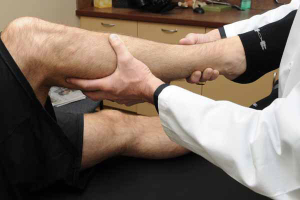The reverse pivot shift test is a dynamic test, similar to the posterolateral drawer test, to assess for posterolateral rotation of the knee. A positive reverse pivot shift test is found in 35% of normal knees, so it is very important to compare this test to the contralateral knee.
Performance of this test is with the knee flexed to approximately 80°-90°, with a valgus and external rotation force applied to the knee. In this position, the tibia would be subluxed posterolaterally for a positive test. The knee is then extended. If the tibia is posterolaterally subluxed, the iliotibial band will reduce it as it goes from a flexor to extender of the knee and a visible reduction of the tibia on the femur can occur. Once again, it is very important to compare a positive test to the contralateral knee to verify that this is not a normal physiologic increase in rotation.

